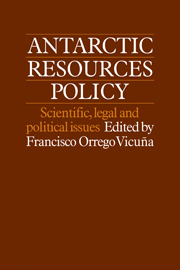Book contents
- Frontmatter
- Contents
- List of contributors
- 1 Antarctic resources policy: an introduction
- Part one The state of Antarctic knowledge and experience
- Part two The policy for the conservation of the living resources of Antarctica
- Part three The policy for the exploration and exploitation of the mineral resources of Antarctica
- Part four Issues on Antarctica and the law of the sea
- Part five The policy for Antarctic cooperation
- 20 Antarctica's role in international relations
- 21 Alternatives for cooperation and institutionalization in Antarctica: outlook for the 1990s
- 22 Resource development in polar regions: comments on technology
21 - Alternatives for cooperation and institutionalization in Antarctica: outlook for the 1990s
Published online by Cambridge University Press: 06 July 2010
- Frontmatter
- Contents
- List of contributors
- 1 Antarctic resources policy: an introduction
- Part one The state of Antarctic knowledge and experience
- Part two The policy for the conservation of the living resources of Antarctica
- Part three The policy for the exploration and exploitation of the mineral resources of Antarctica
- Part four Issues on Antarctica and the law of the sea
- Part five The policy for Antarctic cooperation
- 20 Antarctica's role in international relations
- 21 Alternatives for cooperation and institutionalization in Antarctica: outlook for the 1990s
- 22 Resource development in polar regions: comments on technology
Summary
Introduction
Assessments of the Antarctic Treaty and the Antarctic Treaty system tend to be oriented toward the 1930s. Though the next decade is perhaps a logical point of future reference, this orientation derives as much from a wide-spread perception that the Treaty will expire or at least is up for renewal in 1991.
In fact, the Treaty is of indefinite duration. However, Article XII, paragraph 2, does provide for the possibility of a conference to review the operation of the Treaty thirty years after entry into force (which occurred in 1961) as well as the possibility of withdrawal from the Treaty if amendments adopted by such a review conference have not entered into force within two years.
To the drafters of the Treaty thirty years must have seemed a period sufficient to judge the workings of the Treaty system and thus an appropriate time to evaluate its effectiveness. It is the purpose of these remarks to seek to anticipate such an assessment. To do so requires an analysis of the Antarctic Treaty and the Antarctic Treaty system from an institutional perspective – specifically, what institutions are provided for in the Treaty, how the Treaty system has evolved from an institutional perspective and what might be the future trends in such evolution.
- Type
- Chapter
- Information
- Antarctic Resources PolicyScientific, Legal and Political Issues, pp. 281 - 296Publisher: Cambridge University PressPrint publication year: 1983

